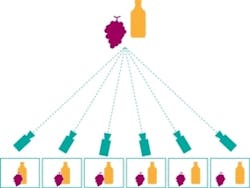NLT Technologies introduces no-glasses multi-view 2D/3D display
Kawasaki, Japan--NLT Technologies (NLT) has developed a new autostereoscopic multiview display based on the company's HxDP (Horizontally x times-Density Pixels) technology. The low-temperature polysilicon thin-film-transistor (TFT) color 2D/3D LCD module prototype has a wide quarter video graphics array (WQVGA) resolution of 384x240 pixels that enables autostereoscopic images.
The 3.1-in. (79 mm diagonal), six-view display prototype enables users to view high-density stereoscopic images without 3D glasses. The prototype has a wide stereoscopic viewing angle and NLT’s multiview technology with data from six cameras.
“As interest in 3D technologies increases for consumer and industrial markets, there is a growing need to support both two-view and multi-view technologies and products, particularly for applications like 3D CAD/CAM, gaming, or medical imaging,” said Omid Milani, vice president of displays at Renesas Electronics America, one of NLT's sales and marketing channels.
3D-based movies, TV, and mobile phones have been gaining popularity worldwide, but most are based on two-view technology, which is adequate for traditional broadcasting and TV systems. However, autostereoscopic displays can support multiple views, which provides a more natural 3D viewing experience, according to NLT. The company’s HxDP technology is an improvement to its HDDP (Horizontally Double-Density Pixels) technology, allowing more than two views.
Conventional LCDs are based on square pixel arrangements, with RGB sub-pixels distributed in vertical stripes with two pixels required to display a 3D image, cutting the display’s horizontal resolution in half. With NLT’s HxDP technology, the six-view, 2D/3D 3.1-in. display prototype module is composed of horizontally striped RGB color pixels, each consisting of three sub-pixels that are striped horizontally and split in 1/6 lengthwise. Alternating displays of the horizontal pixels for each eye produces the desired 3D images. The HxDP technology also makes it possible for 2D and 3D images to be displayed simultaneously in the same resolution on the same screen without the need for 3D glasses.
The 3.1-in. HxDP module will be on display in the NLT Technologies and Renesas Electronics America booth (#343) at Display Week 2012 at the Boston Convention and Exhibition Center, Boston MA, June 5-7.
About the Author
John Wallace
Senior Technical Editor (1998-2022)
John Wallace was with Laser Focus World for nearly 25 years, retiring in late June 2022. He obtained a bachelor's degree in mechanical engineering and physics at Rutgers University and a master's in optical engineering at the University of Rochester. Before becoming an editor, John worked as an engineer at RCA, Exxon, Eastman Kodak, and GCA Corporation.

